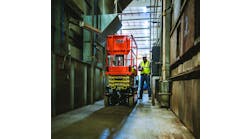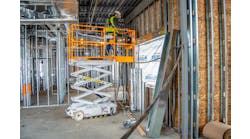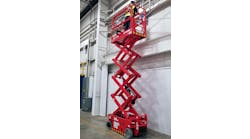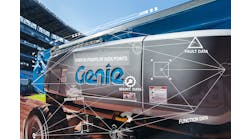Participants:
John Bartz, emission solutions manager, Volvo Construction Equipment
Tom Bucklar, marketing support manager, Caterpillar
Robert Desel, vice president Americas & Asia, Terex Construction
Michael Gidaspow, product manager, wheel loaders, Komatsu America Corp.
Anker Henningsen, global sales and marketing manager, Cat Work Tools
Blaine Pressley, segment manager, Volvo Construction Equipment
Dan Rafferty, North American attachments manager, Volvo Construction Equipment
Terry Rasmussen, marketing supervisor, Caterpillar
Jacob Thomas, senior vice president, product development, marketing and Terex Business System, Terex Corp.
Mark Wall, product marketing manager for excavators, Deere and Hitachi
Tom Winter, sales support general supervisor, Cat Work Tools.
RER: What are some of the new technological developments in your equipment?
Pressley: We've just come out with a new feature called OptiShift, an exclusive Volvo feature. It is two items: One is a lock-up torque converter that improves fuel efficiency and productivity mostly on load-and-carry operations. The other feature is the reverse-by-braking, we call it RBB. It helps in truck-loading applications, for example, an operation where you're constantly loading, backing up, pulling forward, dumping and going back to the pile.
When you back up out of a pile you normally shift from reverse to forward while going backwards. The torque converter and entire driveline has to slow the machine down as you switch from reverse to forward and throttle up. Our innovation puts the transmission in neutral and engine at idle RPM as you shift from reverse to forward, for example, and uses the service brakes to slow the machine down automatically. So the operator doesn't have to touch the brake pedal, it's all done electronically. With the OptiShift we're seeing up to 15-percent fuel savings compared with a normal system. That's a huge number.
Another Volvo exclusive is the full suspension articulated hauler. It has a fully hydraulic suspension system that automatically adjusts to center the load and shifts hydraulic fluid to the cylinders as needed when cornering. It gives the operator a smoother ride and better productivity in rougher terrains.
Bartz: Tier 4 is the technology that is compelling everyone. With wheel loaders, it depends on the size. Wheel loaders with more than 175 horsepower will be affected by Tier 4 beginning in 2011. Smaller wheel loaders will be affected in 2012. You'll see the inclusion of diesel particulate filters and all the other supporting technology that comes with that.
Wall: Probably the biggest new developments in the excavator lines are emissions technology and telematics. Emissions has been on everybody's change pattern here since the late ‘90s, and continuing to progress to reduce NOx and particulates up through Tier 3 in 2005-6. Now we're all preparing for the next round of emissions regulations, the Interim Tier 4, with those changes for the U.S. market taking effect in January of 2011.
The past couple of years there has been great emphasis on telematics, getting information off of the machine to the customer for several purposes. We have JD Link at John Deere and Hitachi, which we offer as standard equipment on excavators that weigh 20 metric tons and above, including three years of communications so you get the hardware and three years of communications.
Gidaspow: Komatsu is continuously working to improve our products. Some of the latest examples are our WA150-6 through WA320PZ-6 wheel loaders, powered by a Hydrostatic Transmission (HST). HST gives these loaders excellent machine response, quick acceleration, plenty of power and very low fuel consumption. Our -6 models also have Variable Traction Control with S-Mode, which reduces the tractive effort of the machine, easing operation in applications where tires are prone to slipping. This improves productivity and increases tire life. Finally, Komatsu's construction equipment comes standard with Komtrax, Komatsu's wireless equipment monitoring system. Komtrax is constantly being upgraded to offer benefits, such as viewing of fuel consumption and actual working hours.
Bucklar, Rasmussen: The AccuGrade product line has expanded in breadth and level of integration. In breadth, it has expanded to asphalt pavers and skid-steer loaders. With respect to Integration, the pavers now come with Cat Grade Control from the factory.
Thomas: Right now, we are working on developing and evolving technologies related to electrical controls, hydraulic controls, improved ergonomics/cab design, telematics, and hybrids, to name a few. We are also heavily engaged to get Terex equipment ready for Tier-4 compliance. This isn't limited to just a change in engine placement on the machine and/or a change in engine manufacturers, but it also affects how the Tier-4 engine will work with all other components in the machine, as well as its overall performance.
What are some of the trends you expect to see in earthmoving equipment in the foreseeable future?
Pressley: The key is going to be lowering operating costs. Cash flow is number one on everybody's mind. In terms of rental equipment, when the economy begins to improve, and there are signs of it, people will tend to rent before they purchase.
Wall: We're just scratching the surface with telematics. As electronics progress all that information will be able to be transmitted back to somebody and with the computer they can interpret data from how many hours in the day, how much fuel you are burning, utilization rates and more. We'll see a lot of growth in the near term.
Gidaspow: The Tier-4 emissions laws will have the biggest impact on earthmoving equipment in the near future. With these new emissions laws, manufacturers are challenged to make equipment that has cleaner exhaust. Also, as fuel prices are expected to continue to increase, equipment manufacturers are challenged to provide this equipment with lower fuel consumption and higher productivity to help keep operating costs down.
Thomas: Primary challenges relate to achieving Tier-4 compliance and manufacturers and engine suppliers being able to meet the changing requirements for emissions and fuel in a cost-effective manner that is least disruptive to our customers. Also, incorporating technology to improve operator comfort and productivity is a focal point.
Our customers view the cab of their machines as their “office,” so it is our job to design and build machines that they can be most productive in all day long. These technical changes need to be integrated while improving the uptime of our machines.
Other industry trends, not necessarily all related to technology, include: the ability to import and export construction equipment across international borders, to manage and service different generations of equipment, to handle used equipment inventory, to increase equipment utilization rates and to better manage existing equipment assets.
What kinds of developments do you see in attachments?
Rafferty: In the past, wheel loaders would use a general purpose (GP) bucket for every customer. People would use the GP bucket to dig dirt, dig rock, re-handle trash and waste — whatever they needed done.
Customers are going to take advantage of the attachment brackets on wheel loaders to use more specialized attachments for each job on the site. So if you're digging in rock, you're going to get a rock bucket.
We recently came out with a re-handling bucket. It's a specialized bucket, with a lower height, so you can see over the top a little bit better. It has a longer floor to increase the capacity and to help the operator see where the cutting edge is located. It has side cutters in line with the bucket sides so it offers less resistance when penetrating material and fewer edges when material can stick and lower the volume of material carried during each load cycle. The combination of these features provide customers with faster bucket fill, better visibility, higher overall bucket fill factors and more material transported in cycle. The wear plates are made of HP 500 steel so wear and replacement costs are reduced.
Gidaspow: Visibility is becoming a higher priority for attachment manufacturers. They are continuously working to make attachments that have better visibility.
Henningsen: We see a move to more assist for mounting/demounting attachments whether hydraulic, air or electric. We see a more integrated approach with machine design, for more complementary jobsite solutions as opposed to a tool for the job. We see more complete hydro mechanical jobsite solutions with enhanced tool coupling systems.
Thomas: The trend continues to be that customers are asking for, and in some cases, requiring more and more hydraulic performance out of their equipment. Also, we see a trend in the market for attachments to become more standardized across the industry. Our customers want to be able to use their attachments on multiple pieces of equipment, not particular to a specific brand.
What is new in the attachment market? Are there new attachments that have good potential?
Gidaspow: JRB has introduced a new wheel loader quick coupler that will pick up both JRB 416 style attachments, as well as ISO style attachments. This will make it possible for a customer to use two different styles of attachments on the same wheel loader. This now gives the customer more options when purchasing a wheel loader because he is not constrained to one style of attachment. This new coupler also has improved visibility over its predecessor. We've heard excellent feedback from our customers who have this coupler on Komatsu wheel loaders.
Henningsen, Winter: Caterpillar work tools has recently developed and launched new coupler systems for medium-sized wheel loaders and the hydraulic excavator line. Also, a new medium wheel loader bucket has been created to increase machine production.
What is your expectation on the overall construction economy as it pertains to the earthmoving industry and to the potential for rental — short term and long term?
Pressley: We are seeing some signs of change; our order intake is up somewhat, but it's too early to tell. We have seen some positive signs, but there are two key things that have to happen first for construction equipment manufacturers. Housing starts have to come back, and then the road bills. Most of the stimulus funding for road work may come this year; that has to happen.
Desel: We are seeing pockets of strength in the construction equipment business, but there is still quite a bit of used equipment that needs to be utilized before we will see a significant increase in sales of new equipment. Rental stands to benefit from some of the uncertainty in the size and scale of the recovery. We see RPOs as a key part of this journey from no activity to rental to purchase.
What are some of the trends you expect to see regarding fuels?
Bartz: We'll continue to see demand for bio-fuels. The legislature has not renewed the dollar-a-gallon incentive for biodiesel, but it is expected to pass; B-20 is a valid biodiesel to use in the field. What's happening with fuels will phase in ultra-load sulphur diesel in the offroad section, in preparation for Tier 4, Jan. 1, 2011.
Volvo continues to work on a variety of alternative fuels. Three to seven different alternative fuels are being developed on the market. Alternative fuels are very market-driven. What's available in North America or even the West Coast or East Coast may not be available in the rest of the world. Look at what Brazil has done with sugar cane. There are alternative fuels from wood pulp, so if you are in an area that has a lot of that material available, that's a viable alternative fuel. Soybeans as well, and there are various others. That's why we have to look at a wide variety because one alternative fuel won't fit the entire world.
Thomas: Regarding fuels, we anticipate a demand for the advancements and evolution of biofuels and alternate fuels such as CNG in the construction industry — as environmental regulations grow stricter in some urban areas. Also, some Tier-4 technologies are particularly sensitive to the amount of sulfur levels in fuels. There are wide variations in the sulfur level of fuel in various areas of the world. We are working closely with our engine suppliers to respond to that requirement as well.
What about “environmental” machines such as hybrids or electric-powered vehicles? Do you expect to see major growth in these niches with earthmoving products?
Bartz: If you attended ConExpo, you probably saw Volvo's display of the world's first hybrid wheel loader. Technology has moved so quickly that this specific technology was quickly outpaced. Volvo continues to work on hybrid technology, and you can see it across our different product lines such as Volvo and Mack trucks. We are all working on hybrids and sharing the technology across all Volvo companies. What Volvo CE will focus on in the near future is specifically fuel consumption. We will continue to work on our engines and how engines are integrated into our machines. It's not always the engine that can produce the biggest fuel consumption gains, it's how you install it, the things you put around it, even what attachments you put on the front of it. Volvo will be very active in operator training, which is another huge part of fuel savings.
Wall: There's a lot of talk about it. Anything that has to do with a hybrid or electric vehicle has to make sense for the contractor. As a manufacturer, we have to supply what the contractor wants and needs, so the contractor will shape that. If they decide diesel fuel is too expensive there will be a bigger call for hybrids or electric power; if diesel fuel stays at a reasonable price, and in North America it's a lower part of their operating budget compared to labor and overhead, then in North America they may think less about that. In other parts of the world where diesel fuel is more expensive and their business is run differently and the cost of the fuel is a more significant part of their costs, there might be more emphasis on hybrids or alternately powered vehicles.
Gidaspow: Komatsu just introduced the first hybrid hydraulic excavator into the market. We've had numerous customers asking about this product and we expect to grow our sales of this product over the next few years. There is definitely a market for customers who want to minimize their carbon footprint and reduce their fuel consumption by 25 to 40 percent.
Thomas: As the demand grows for more environmentally friendly options — particularly in larger machines — including biofuels, hybrids and electric-powered machines, the required technologies will evolve. Right now, much of this technology is limited to niche applications and is quite costly.
For a full transcript of the interviews, visit rermag.com.





